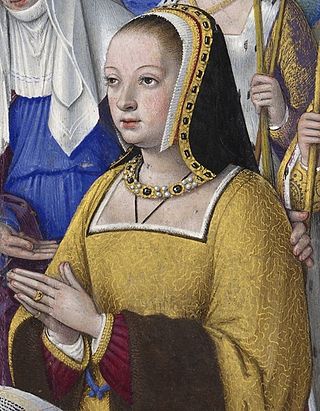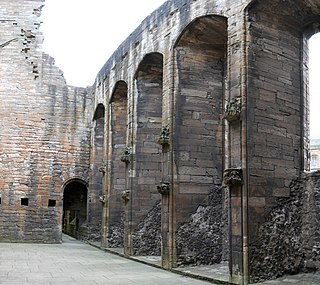Related Research Articles

James V was King of Scotland from 9 September 1513 until his death in 1542. He was crowned on 21 September 1513 at the age of seventeen months. James was the son of King James IV and Margaret Tudor, and during his childhood Scotland was governed by regents, firstly by his mother until she remarried, and then by his second cousin, John, Duke of Albany. James's personal rule began in 1528 when he finally escaped the custody of his stepfather, Archibald Douglas, Earl of Angus. His first action was to exile Angus and confiscate the lands of the Douglases.
Sir Andrew Barton was a Scottish sailor from Leith. He gained notoriety as a privateer, making raids against Portuguese ships. He was killed in battle and memorialised in English and Scottish folk songs.

The Royal Scots Navy was the navy of the Kingdom of Scotland from its origins in the Middle Ages until its merger with the Kingdom of England's Royal Navy per the Acts of Union 1707. There are mentions in Medieval records of fleets commanded by Scottish kings in the twelfth and thirteenth centuries. King Robert I, developed naval power to counter the English in the Wars of Independence (1296–1328), and after the establishment of Scottish independence continued to build up naval capacity. In the late fourteenth century naval warfare with England was conducted largely by hired Scots, Flemish and French merchantmen and privateers. King James I, took a greater interest in naval power establishing a shipbuilding yard at Leith and probably created the office of Lord High Admiral.
The Treasurer was a senior post in the pre-Union government of Scotland, the Privy Council of Scotland.

Sir James Hamilton of Finnart was a Scottish nobleman and architect, the illegitimate son of James Hamilton, 1st Earl of Arran, and Marion Boyd of Bonshaw. Although legitimated in 1512 while still a minor, he continued to be known as the "Bastard of Arran". As a key member of the Hamilton family, and second cousin of James V, King of Scotland, he became a prominent member of Scottish society.
Margaret was a Scottish warship of the 16th century.
John Tennent or Tennand of Listonshiels was a servant and companion of King James V of Scotland. He kept an account of the king's daily expenses which is an important source document for the Scottish royal court.
James Kirkcaldy of Grange, a Fife laird and treasurer of Scotland.
Lion was the name of five warships of the Royal Scottish Navy during the 16th century, some of which were prizes captured by, and from the English. The names of these ships reflect the Royal Arms of Scotland and its central motif of the Lion Rampant.
Treasurer was a Scottish warship in the Royal Scots Navy in the 16th century.
Sir Archibald Douglas of Kilspindie, also known as Greysteil, was a Scottish nobleman and courtier, who served as Treasurer of Scotland, and was three times Provost of Edinburgh.
Katherine Bellenden was a courtier working in the wardrobe of James V of Scotland. Her niece of the same name was similarly employed.

Moubray House, 51 and 53 High Street, is one of the oldest buildings on the Royal Mile, and one of the oldest occupied residential buildings in Edinburgh, Scotland. The façade dates from the early 17th century, built on foundations laid c. 1477.
Isobel Hoppar or Hopper was a Scottish landowner and governess of Margaret Douglas. She was a powerful political figure in Scotland during the youth of King James V, and her wealth and influence attracted misogynous comment from her faction's enemies.
The Comptroller of Scotland was a post in the pre-Union government of Scotland.
Sir John Smith of Grothill and Kings Cramond was a 17th-century Scottish landowner and merchant who served as Lord Provost of Edinburgh from 1643 to 1646.

Guy Foulcart, was a sea captain from Brittany.

William Danielstoun or Dennestoun was keeper of Linlithgow Palace for James V of Scotland.

Elizabeth Sinclair was a servant of Margaret Tudor (1489-1541), the wife of James IV of Scotland.

John Mowbray of Barnbougle was a Scottish landowner and supporter of Mary, Queen of Scots.
References
- ↑ Accounts of the Treasurer of Scotland, vol. 1 (Edinburgh, 1877), p. 344.
- ↑ Accounts of the Treasurer of Scotland, vol. 2 (Edinburgh, 1900), pp. 29, 280.
- ↑ Accounts of the Lord High Treasurer of Scotland, vol. 3 (1901).
- ↑ Hay, Denys, Letters of James V (HMSO, 1954), p. 401.
- ↑ Ellis, Henry, Original Letters Illustrative of English History, 1st Series, vol. 1 (London, 1825), p. 98
- ↑ Teulet, Alexandre, ed., Relations politiques de la France et de l'Espasgne avec l'Écosse, vol. 1 (1862), pp. 75-6
- ↑ Hay, Denys, Letters of James V (HMSO, 1954), pp. 108, 310-311.
- ↑ Register of the Privy Seal of Scotland, vol. 1 (1908), p.592 no.4104, 6 March 1529
- ↑ State Papers Henry VIII, vol. 4 part 4 (London, 1836), p. 213, Magnus & Radclyff to Wolsey, 2 November 1524.
- ↑ Athol Murray, 'Exchequer, Council and Session, 1513-1542', Janet Hadley Williams, Stewart Style (East Linton: Tuckwell, 1996), p. 110.
- ↑ Acts of Sederunt of the Lords of Council and Session (Edinburgh, 1811), pp. 28–9.
- ↑ Register of The Great Seal: 1513-1546 (Edinburgh, 1883), p. 396 no. 1779.
- ↑ Accounts of the Treasurer of Scotland, vol. 7 (Edinburgh, 1907), p. 484.